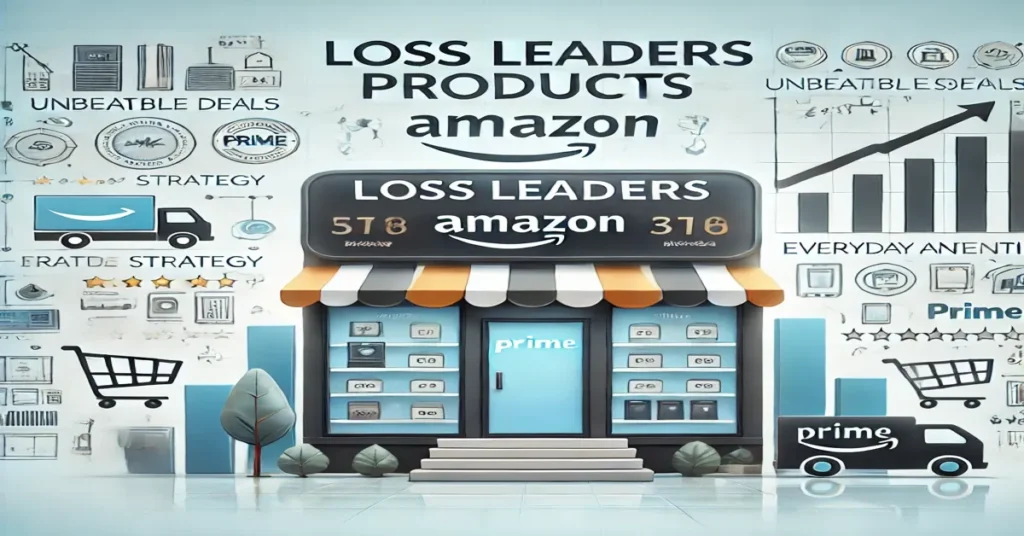Amazon has transformed e-commerce with its innovative strategies consistently drawing customers with deals that seem too good to be true. Have you ever wondered how Amazon manages to sell certain products at a loss while remaining a market leader? The answer lies in a pricing tactic called “loss leaders.”
Loss leader products are an integral part of Amazon’s business model. These products are sold at or below cost to attract customers, who then purchase additional items at profitable margins. This article explores how Amazon leverages loss leader products to dominate the e-commerce space, why the strategy is so effective, and what it means for consumers and competitors.
Understanding Loss Leaders: What Are They?
Loss leaders are products sold at a reduced price—even at a loss—to drive customer traffic and encourage additional purchases. This marketing strategy relies on the psychology of consumer behavior once a shopper is drawn in by a great deal, they’re likely to purchase other items, compensating for the initial loss.
Key Characteristics of Loss Leaders
- Attractive Pricing: These products are priced significantly lower than competitors or below market value.
- High Demand: Loss leaders are often popular items that draw significant attention.
- Strategic Placement: They are typically highlighted in marketing campaigns to lure shoppers to the platform.
How Amazon Utilizes Loss Leaders Products
Amazon has mastered the art of using loss leaders to boost its e-commerce dominance. The strategy is evident in several aspects of its operations.
Highlighting Bestsellers
Amazon identifies products that resonate with a wide audience, such as household essentials, books, or tech gadgets, and offers them at unbeatable prices. These deals attract millions of customers to the platform.
Driving Ecosystem Loyalty
Loss leaders are often tied to Amazon’s broader ecosystem, such as promoting Prime memberships or its branded products.
- Amazon Prime: Offering discounted or free products exclusively for Prime members encourages subscriptions, driving long-term customer loyalty.
- Amazon Devices: Products like the Kindle or Echo are often sold at a loss to lock users into the Amazon ecosystem.
Boosting Sales Through Cross-Selling
Once customers are on Amazon’s platform, they’re presented with personalized recommendations and upselling strategies. This increases the likelihood of purchasing additional items, compensating for the loss leader.
Seasonal Promotions
Amazon heavily features loss leaders during major shopping events like Black Friday, Prime Day, and Cyber Monday. These promotions create a sense of urgency and drive massive traffic.
Why Loss Leader Strategy Works for Amazon
The success of loss leaders at Amazon lies in its ability to leverage scale, data, and customer loyalty.
Massive Customer Base
With millions of daily visitors, Amazon’s reach ensures that even a small percentage of additional purchases can offset losses on heavily discounted products.
Advanced Analytics
Amazon’s data-driven approach allows the company to predict purchasing behaviors. By analyzing customer preferences, Amazon tailors its loss leader strategy to maximize profitability.
Ecosystem Integration
Amazon’s interconnected ecosystem of products and services ensures that customers are continually engaged. Loss leaders serve as entry points to this ecosystem, creating long-term value.
Examples of Loss Leaders Products Amazon
Several product categories exemplify Amazon’s loss leader strategy.
Amazon Devices
Devices like the Echo Dot, Fire Stick, and Kindle are sold at minimal margins—or even losses—to encourage users to engage with Amazon’s services, such as Alexa, Prime Video, and Kindle eBooks.
Bestselling Books
Amazon often discounts popular books to below-market prices. While the books themselves may not generate significant profit, they attract avid readers who purchase additional items.
Everyday Essentials
Household products like cleaning supplies, toiletries, and groceries are often discounted to draw repeat customers. These items encourage bulk purchases and loyalty.
Tech Gadgets
Amazon offers competitive pricing on tech products like headphones, smartwatches, and gaming accessories, appealing to a tech-savvy audience.
Impact on Consumers
The loss leader strategy benefits consumers in multiple ways but also raises important considerations.
Benefits
- Cost Savings: Customers can purchase popular products at unbeatable prices.
- Convenience: Once on the platform, shoppers enjoy Amazon’s fast delivery and vast selection.
- Access to Exclusive Deals: Prime members gain access to exclusive loss leader discounts.
Considerations
- Impulse Buying: Attractive deals may lead to unplanned purchases.
- Ecosystem Lock-In: Discounted products often tie consumers to Amazon’s ecosystem, reducing flexibility.
Impact on Competitors
Amazon’s aggressive use of loss leaders creates challenges for competitors, especially smaller retailers.
Price Wars
Amazon’s ability to absorb losses puts pressure on competitors to lower prices, often at the expense of their profit margins.
Customer Loyalty Challenges
By tying loss leaders to its ecosystem, Amazon makes it harder for competitors to attract and retain customers.
Barrier to Entry
New entrants in the market struggle to compete with Amazon’s scale and pricing strategies, reducing market diversity.
Ethical and Regulatory Concerns
The use of loss leaders isn’t without controversy. Critics argue that it can create unfair competition and harm smaller businesses.
Anti-Competitive Practices
Some regulators have scrutinized loss leader strategies, viewing them as a means to monopolize markets by undercutting smaller competitors.
Consumer Manipulation
Critics also point out that loss leader pricing can encourage impulsive buying, potentially leading to unnecessary spending.
How Businesses Can Compete with Amazon’s Strategy
While Amazon’s loss leader approach is formidable, there are ways for other businesses to compete effectively.
Emphasize Niche Markets
Smaller retailers can focus on niche markets where personalized service and specialized products offer a competitive edge.
Build Customer Relationships
Strong customer service, loyalty programs, and community engagement can differentiate smaller retailers from Amazon.
Leverage Unique Selling Propositions
Offering unique, high-quality products or experiences can attract customers who value something different from Amazon’s mass-market approach.
Future of Loss Leaders Products Amazon
The loss leader strategy will likely remain central to Amazon’s business model as it evolves.
Enhanced Personalization
With advancements in AI, Amazon can refine its loss leader offerings, tailoring them to individual customers for maximum impact.
Expanding Categories
Amazon may introduce loss leaders in emerging categories such as sustainable products, health tech, or virtual reality gadgets.
Increased Ecosystem Integration
As Amazon continues to grow its ecosystem, loss leaders will play a key role in driving adoption of new services and products.
Conclusion
Loss leaders products Amazon pricing strategy is a cornerstone of the company’s e-commerce dominance. By offering unbeatable deals on popular items, Amazon attracts millions of customers, builds loyalty, and drives profitability through cross-selling and ecosystem integration. While the strategy benefits consumers with cost savings and convenience, it also raises challenges for competitors and ethical questions about market dynamics. As Amazon continues to innovate, the role of loss leaders will remain a defining element of its success.
FAQs
What are loss leaders products on Amazon?
They are items sold at a loss or minimal profit to attract customers and encourage additional purchases.
Why does Amazon use loss leaders?
Amazon uses loss leaders to drive traffic, build customer loyalty, and promote its ecosystem of products and services.
What are examples of loss leaders on Amazon?
Examples include Amazon devices like Echo and Kindle, bestselling books, and everyday essentials.
How does this strategy impact competitors?
It creates intense price competition, making it difficult for smaller retailers to compete.
What are the benefits of loss leaders for consumers?
Consumers benefit from significant savings and access to exclusive deals.
Is the use of loss leaders ethical?
While beneficial for consumers, the strategy raises concerns about anti-competitive practices and its impact on small businesses.







